Switzerland (Head Quarters)
IDR Medical Switzerland
Austrasse 95, CH-4051 Basel, Switzerland
T:
+41 (0) 61 535 1109
UK
IDR Medical UK
Unit 104 Eagle Tower, Eagle Tower
Montpellier Drive, Cheltenham, GL50 1TA
T:
+44 (0) 1242 696 790
USA
IDR Medical North America
225 Franklin Street, 26th Floor
Boston, Massachusetts 02110, USA
T:
+1 (0) 617.275.4465
.jpg)
Using Conjoint Analysis To Optimize Medical Device Design
Learn how conjoint analysis with IDR Medical can help you gain valuable insights, create a successful medical device pricing strategy, and optimize product design.
Conjoint analysis is a method of research that assesses and quantifies the importance customers assign to various aspects of a product or service by analyzing trade-offs. This method is used in various markets involving simple and complex products and services.
IDR Medical is a renowned global medical market research and consulting company that has played a pioneering role in the conjoint analysis formula. Offering its services to leading pharmaceutical and medical device firms worldwide, utilizing conjoint methodologies to uncover insights and inform strategic decision-making.
Many different conjoint methods are available for evaluating customer responses to products and determining their preferences. These methods are advantageous because they can be customized to measure responses to various aspects of a product, such as its attributes, design, value, brand perception, and price sensitivity.
See how to leverage conjoint analysis to optimize medical device design, by downloading IDR Medical's ultimate Guide to using Conjoint In Medical Device Market Research.
This guide covers five different conjoint analysis methods—traditional full-profile conjoint, adaptive conjoint, choice-based conjoint, adaptive choice-based conjoint, and menu-based conjoint.
This article will discuss how each method works and help you determine the most appropriate approach to inform your research and development priorities and determine an optimal medical device pricing strategy.
What is conjoint analysis?
Conjoint analysis is a form of statistical analysis that firms use in market research to understand how customers value different components or features of their products or services. It’s based on the principle that any product can be broken down into a set of attributes that ultimately impact the perceived value of an item or service.
Conjoint analysis is typically conducted via a specialized survey where respondents are presented with a series of hypothetical scenarios or product profiles that vary in certain attributes or features. These attributes could include price, brand, design, functionality, or other relevant factors depending on the context of the survey. Each scenario typically presents a set of options from which the respondents must choose their preferred or most preferred option.
By systematically varying the attributes and levels across different scenarios, researchers can analyze the trade-offs and preferences expressed by respondents. The results of the survey help to quantify the relative importance of different attributes and provide insights into how consumers make decisions and what factors drive their choices.
Conjoint surveys are widely used in market research, product development, pricing strategies, and marketing campaigns. They provide valuable information for businesses to understand customer preferences, optimize product features, design effective marketing strategies, and predict consumer behavior in real-world market scenarios.
Why use conjoint analysis to optimize your medical device?
Conjoint can specifically aid medical device market research, optimizing design and gauging price sensitivity.
IDR considers this to be hugely valuable to ensure that your medical device best meets the needs of patients, physicians, and purchasers within the healthcare industry.
Conjoint analysis can help in several ways:
Product Development
Conjoint analysis can assist in determining the most desirable attributes and levels for a new product or service. By analyzing customer preferences, businesses can make informed decisions about product features, design, pricing, and positioning.
Pricing Strategy
Conjoint analysis can provide insights into how customers value different attributes and how price influences their choices. This information helps businesses in setting optimal prices and understanding the trade-offs customers are willing to make.
Market Segmentation
Conjoint analysis can identify distinct customer segments based on their preferences. By understanding which attributes are most important to different customer groups, businesses can tailor their marketing strategies and product offerings to specific target segments.
Competitive Analysis
By analyzing customer preferences for their own products and those of competitors, medical device manufactures can identify areas of strength and weakness and develop strategies to gain a competitive advantage.
Marketing and Messaging
By understanding which attributes and benefits are most influential in decision-making, businesses can create compelling marketing messages and improve customer engagement.
Forecasting and Simulation
Conjoint analysis can be used to simulate market scenarios and predict customer preferences and market shares for new or modified products. This helps businesses make informed decisions about product launches, expansion into new markets, or changes to existing offerings.
Types of conjoint analysis methods: what you need to know
There are five main types of conjoint analysis methods:
Full-Profile Conjoint Analysis
In this form of conjoint analysis, respondents are provided with detailed descriptions of products to assess their preferences based on specific attributes. Respondents are asked about their preferences instead of their likelihood of purchasing. The information is collected through web surveys that present different product descriptions or products to evaluate preference or suitability.
Here is an example of how this methodology can be applied.
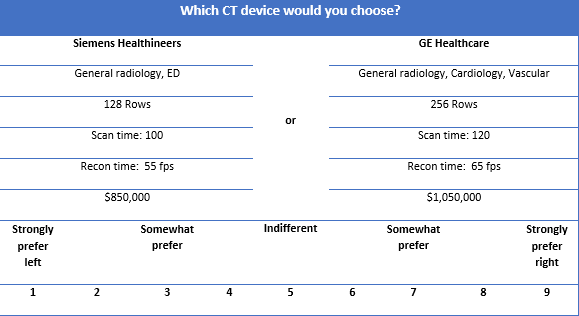 *Examples provided are purely for illustrative purposes and are unrelated to any IDR Medical projects
*Examples provided are purely for illustrative purposes and are unrelated to any IDR Medical projects
Adaptive Conjoint Analysis (ACA)
Adaptive Conjoint Analysis (ACA) methods involve trade-off analysis and are structured over several sections. Here, the survey is customized for each respondent. Follow-up questions are based on the previous answers of the participants. This method helps identify the respondent's preferred product features or specifications.
This is an example of a typical ACA survey structure:
1. Preference for Levels (Respondent rates the levels in terms of relative preference)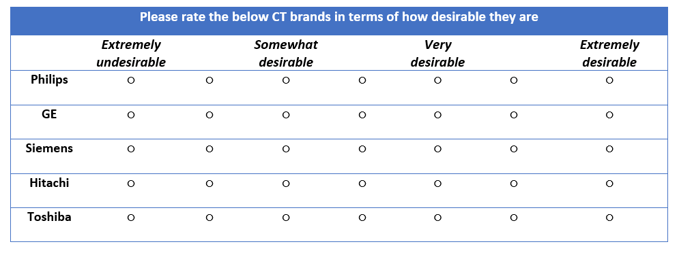 *Examples provided are purely for illustrative purposes and are unrelated to any IDR Medical projects
*Examples provided are purely for illustrative purposes and are unrelated to any IDR Medical projects
2. Attribute Importance (Respondent determines the relative importance of each attribute)  *Examples provided are purely for illustrative purposes and are unrelated to any IDR Medical projects
*Examples provided are purely for illustrative purposes and are unrelated to any IDR Medical projects
3. Paired-Comparison Trade-Off Questions (Respondent is shown two product concepts; they are then asked which is preferred and to indicate the strength of preference) 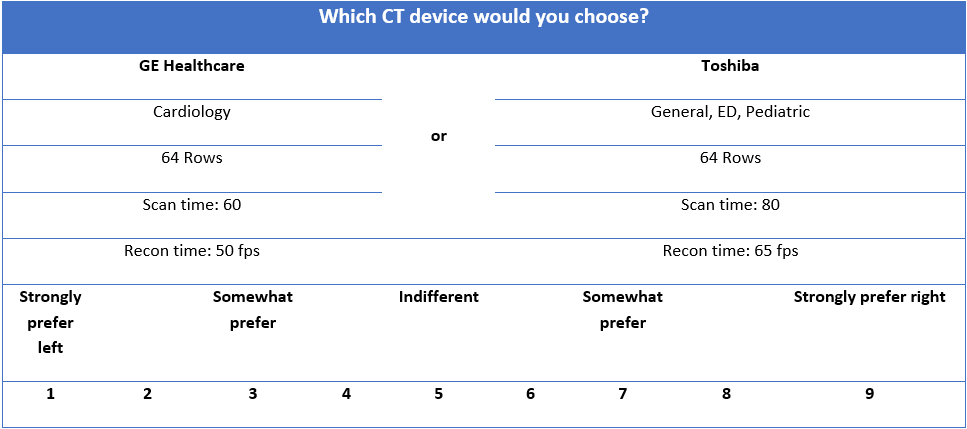 *Examples provided are purely for illustrative purposes and are unrelated to any IDR Medical projects
*Examples provided are purely for illustrative purposes and are unrelated to any IDR Medical projects
4. Calibrating Concepts
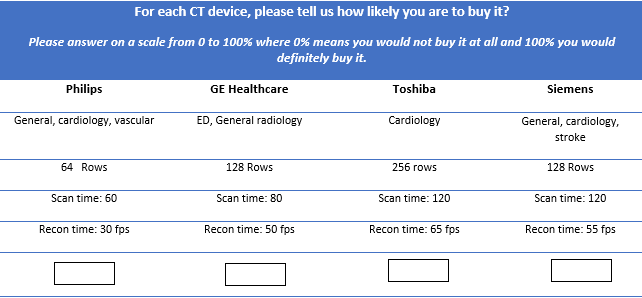
*Examples provided are purely for illustrative purposes and are unrelated to any IDR Medical projects
Choice-based Conjoint (CBC)
This is one of the most common forms of conjoint analysis and is used to identify how a respondent values combinations of features.
In this methodology, participants are given a series of tasks and asked to choose between different product profiles. Each task includes multiple options, and participants also have the option not to select any. The study can replicate a realistic buying scenario by presenting several full-profile descriptions and predicting the participant's purchasing behavior.
This is an example of a Choice-Based Conjoint (CBC):
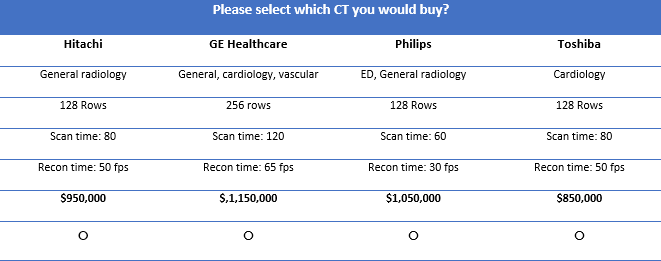
*Examples provided are purely for illustrative purposes and are unrelated to any IDR Medical projects
Adaptive Choice-based Conjoint (ACBC)
Adaptive Choice-Based Conjoint (ACBC) is a survey method that combines Adaptive Conjoint Analysis (ACA) and Choice-based Conjoint Analysis (CBC). This form is ideal for smaller sample sizes and can accumulate more data on individual product features than traditional CBC surveys.
ACBC uses an adaptive process to refine the survey based on the participants' responses. The survey adapts to the participants' preferences by presenting more choice tasks that are most informative and relevant to their decision-making process. This adaptive approach helps to reduce respondent burden and improve the accuracy of the results.
ACBC interviews consist of three main sections:
1) BYO (Configurator)
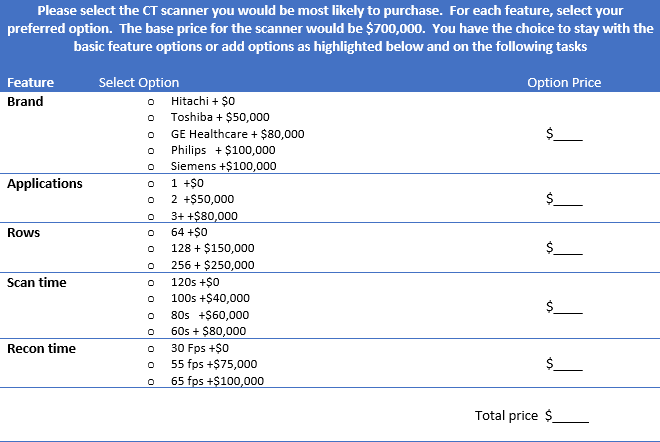
*Examples provided are purely for illustrative purposes and are unrelated to any IDR Medical projects
2) Screening Section
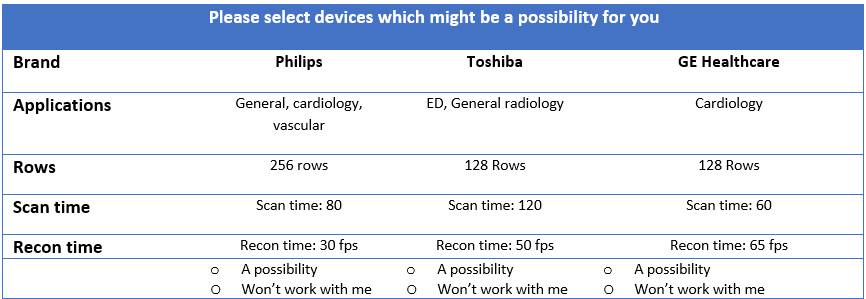
*Examples provided are purely for illustrative purposes and are unrelated to any IDR Medical projects
3) Choice Tasks
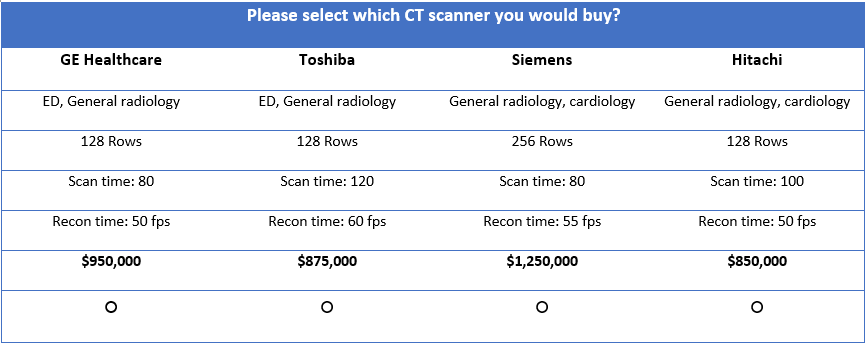
*Examples provided are purely for illustrative purposes and are unrelated to any IDR Medical projects
Menu Based Conjoint (MBC)
Rather than evaluating individual attributes or product concepts in isolation, menu-based conjoint analysis allows respondents to assess the overall desirability or utility of a menu of features. By systematically varying the attribute levels across menus, researchers can estimate the impact of different attribute combinations on customer preferences.
Traditional conjoint analysis often requires respondents to evaluate a large number of attribute combinations, which can be cognitively demanding and lead to respondent fatigue. Menu-based conjoint analysis simplifies the task by presenting respondents with a limited set of menus.
This method is most suited to more complex products and services where there is greater variability in how a product or solution can be deployed, for example, a hospital information system or complex medical imaging solution.
This is an example of an MBC survey task:
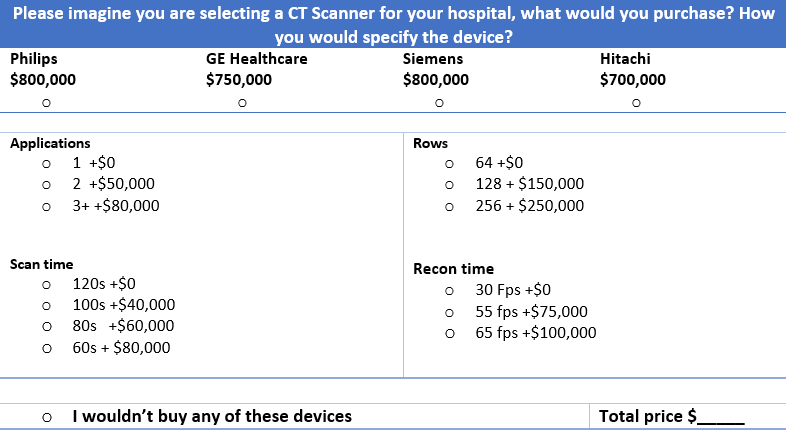
*Examples provided are purely for illustrative purposes and are unrelated to any IDR Medical projects
To learn more about these five conjoint analysis methods in more detail and decide which is ideal for your medical device or product.
Benefits & disadvantages of using conjoint analysis for medical device development
IDR Medical finds utilizing Conjoint analysis extremely useful, yet this method of research heavily depends on what stage of the life cycle your medical device development is in.
It works best if you have already decided on the possible characteristics and attributes of your product, service, or solution. With the flexibility and receptiveness to making modifications based on the outcomes and findings of the process.
Benefits & Disadvantages
Overall, conjoint analysis is a valuable tool for understanding consumer preferences and decision-making processes.
However, researchers should be aware of its limitations and consider complementing it with other research methods to gain a comprehensive understanding of consumer behavior.
|
Conjoint analysis benefits |
Conjoint analysis disadvantages |
|
Realistic decision-making It provides a more realistic representation of how customers make choices in real-life situations, as it considers multiple attributes simultaneously. |
Simplified decision context It presents consumers with simplified scenarios that may not fully capture the complexity of real-world decision-making. |
|
Attribute importance It helps identify the relative importance of different product attributes or features in driving choices. This information is valuable for product design, pricing, and marketing decisions. |
Design complexity Constructing effective conjoint analysis surveys requires careful consideration of attribute levels, combinations, and experimental designs. Designing and implementing conjoint studies can be time-consuming and require statistical expertise. |
|
Market segmentation It enables researchers to segment the market based on customer preferences. This allows for targeted marketing strategies tailored to specific segments. |
Respondent fatigue Conjoint analysis surveys often involve presenting respondents with a large number of choice tasks, which can lead to respondent fatigue and potentially affect the quality of responses. Researchers must be cautious in managing survey length and complexity. |
|
Predictive power It can be used to predict how changes in product attributes or features will impact preferences and market share. This predictive capability assists in making informed business decisions and optimizing product offerings. |
Lack of external factors It typically focuses on product attributes and does not consider external factors, such as brand reputation, social influence, or situational factors. This omission may limit the generalizability of findings to real-world decision-making scenarios. |
Like all research methods, there are some disadvantages. But as a consulting firm dedicated to the healthcare industry, IDR Medical deems conjoint analysis remains an invaluable tool when using the right model and appropriate advisories.
To see first-hand how IDR Medical conducts conjoint analysis, take a look at our case studies.
Our client was a global medical equipment company, and a leader in the diagnostic imaging equipment market. The company approached IDR Medical to define an optimal pricing strategy to launch an advanced extremity MRI scanner with significant improvements over both software and performance on existing devices.
If you're unsure which research method to use, get in touch with one of IDR's experts today.
Let IDR Medical assist with conjoint analysis
IDR Medical is a pioneer in consulting and conducting conjoint analysis for the healthcare industry.
We can assist you with conjoint analysis to:
- Have a greater understanding of your customers and target market
- Improve product design and development
- Form a solid medical device pricing strategy
- Gain valuable insights from data to make an informed business decision
Some key reasons for choosing IDR Medical to assist with your conjoint analysis are:
Experience
We have over a decade of experience in conducting market research tailored to the healthcare industry. We conduct conjoint analysis projects for the leading medical device and pharmaceutical companies worldwide.
Literature
We provide an array of educational resources, including an in-depth guide that gives additional insight into conjoint analysis, with explanations, analysis, features, and recommendations.
Free Consultation
IDR Medical offers a free, non-obligatory primary consultation to discuss and plan a potential project that will address your specific business challenge.
Conclusions
Conjoint analysis data can provide valuable insights into market trends related to medical device pricing, positioning, and design. This information can be beneficial for marketing and sales teams in developing targeted marketing strategies, understanding price positioning, and knowing how to engage with potential buyers effectively.
Our experienced team is waiting to help assist you in choosing the conjoint analysis formula that is best for you.
Want to know more?
Download our free guide on medical device conjoint methods today and learn how we can help you maximize the potential success of your medical devices, products, or services.








